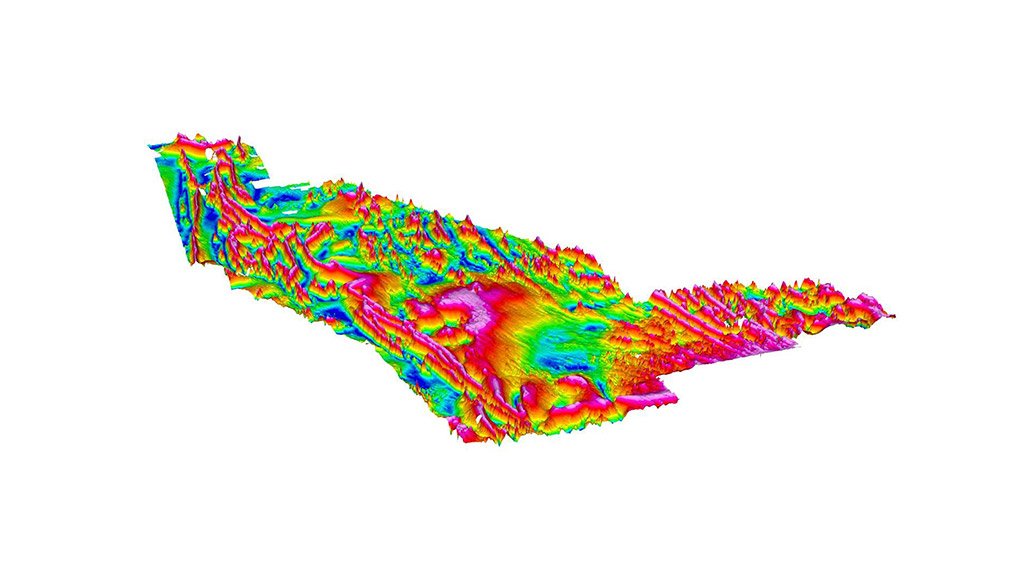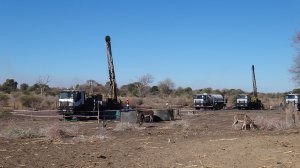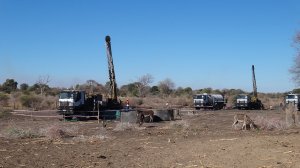Explorer to publish first resource statement on iron-ore project




AMBITIOUS OBJECTIVES Tsodilo Resources plans to complete a first-pass evaluation of the Nxau Nxau general area, in northern Ngamiland for kimberlite deposits in 2014
SEARCHING FOR SUCCESS One of the Tsodilo Resources drill rigs, drilling an inclined hole at the Xaudum iron-ore projec
XAUDAM IRON FORMATION Ground magnetic signature of the Xaudum iron-ore project, looking north for about 35 km
Diamond, base and precious metals exploration company Tsodilo Resources aims to publish a first resource statement for its Xaudum Iron Formation (XIF) iron-ore project by mid-year, says Tsodilo Resources president and COO Dr Mike de Wit.
“This will be the first step towards applying for mining rights at the site,” he tells Mining Weekly, adding that the company also plans to complete a preliminary assessment of two kimberlites in the Nxau Nxau area, in northern Ngamiland.
“We are evaluating the XIF project while our other base metals and diamond projects are in the exploration stages. The metals exploration (excluding iron) is managed by the company’s JV partner, First Quantum Minerals,” De Wit states.
During the last 18 months, the company has focused its exploratory drilling using its own drill rigs in the northern section of the XIF project. This was in preparation for a National Instrument 43-101 technical report, a Canadian mineral resource classification scheme used to disclose information about mineral properties to define the resource of the project.
Tsodilo estimates there is between five-billion and seven-billion tons of exploitable iron-ore resources at the XIF project and that, if mined, it could last up to 100 years, says De Wit.
As the XIF project is in the exploration phase, there is no current turnover. De Wit notes, however, that Tsodilo “has invested many millions of dollars in the project”, which it hopes to recoup quickly once mining operations have been established.
About the XIF Project
The XIF project is a Neoproterozoic banded magnetite iron-ore prospect in the northern portion of the Ngamiland region, in the North-West District of Botswana.
The project is located within two base metals prospecting licences, PL386/2008 and PL387/2008, collectively covering 1534.9 km2.
Tsodilo states that the Neoproterozoic rocks on its projects’ sites are overlain by a sedimentary cover that varies in thickness from 30 m to 40 m, but can be up to 60 m in isolated areas.
The Kalahari cover predominantly comprises lose, unconsolidated sand and some calcrete.
“This cover makes exploration in the area difficult, owing to the lack of outcrop. It requires required geophysical drilling that can access the bedrock below,” emphasises Tsodilo.
Tsodilo regards the XIF project as a major expansion project that will provide many growth opportunities for the Southern African region and particularly for Botswana.
“The XIF project has the spinoff potential to develop into a steel industry, as Botswana also processes substantial coal reserves required to convert the magnetite into pig iron or even steel,” he says.
Industry Overview
Meanwhile, De Wit notes that, while the mining industry in Botswana has been largely focused on diamonds since the first discovery of diamonds in the country in the late 1960s, in the last five years, the Botswana government has realised that diamond mining alone cannot sustain the country’s economy forever.
“Government is therefore trying to stimulate interest in other commodities,” he says.
Base metals, such as copper, lead, zinc, tin and nickel can be found in the Kalahari Copperbelt, which stretches discontinuously for 800 km from central Namibia to northern Botswana. Other commodities such as coal and, uranium, in central Botswana, have been targeted by the Botswana government as areas of potential diversification for the country’s minerals industry, explains de Wit.
“The greatest challenge facing these potential new mining operations is the chronic lack of infrastructure to export these commodities to the global markets. There have been talks about railway lines to Namibia and Mozambique, but progress is slow and several exploration companies have left Botswana for this reason,” he states.
Challenges
De Wit says logistics in north-west Botswana are challenging in terms of ground access for the company’s drill exploration teams.
“These logistical challenges have resulted in Tsodilo having to create access roads to drill sites in the dry season. Further, the restructuring of Botswana’s Department of Mines has led to some delays in processing prospecting licences. Through regular interaction with the Ministry, Tsodilo is trying to resolve these challenges.”
De Wit adds that getting work permits approved for certain critical positions has also been challenging.
He states that, as the company’s main operation is drilling, it applies the standard safety measures around its drill sites. As a result, Tsodilo suffered only one lost-time injury in 2013.
De Wit further mentions that the State has generally been “helpful and supportive of Tsodilo’s operations in the country”.
“Tsodilo makes a point of holding regular community meetings, which keep the local authorities and communities informed about our projects progress,” he states.
To date, the company has created 38 jobs and is stimulating the mining services sector in north-west Botswana.
Additionally, the company is assisting a local school by pro-, viding it with five computers.
Comments
Press Office
Announcements
What's On
Subscribe to improve your user experience...
Option 1 (equivalent of R125 a month):
Receive a weekly copy of Creamer Media's Engineering News & Mining Weekly magazine
(print copy for those in South Africa and e-magazine for those outside of South Africa)
Receive daily email newsletters
Access to full search results
Access archive of magazine back copies
Access to Projects in Progress
Access to ONE Research Report of your choice in PDF format
Option 2 (equivalent of R375 a month):
All benefits from Option 1
PLUS
Access to Creamer Media's Research Channel Africa for ALL Research Reports, in PDF format, on various industrial and mining sectors
including Electricity; Water; Energy Transition; Hydrogen; Roads, Rail and Ports; Coal; Gold; Platinum; Battery Metals; etc.
Already a subscriber?
Forgotten your password?
Receive weekly copy of Creamer Media's Engineering News & Mining Weekly magazine (print copy for those in South Africa and e-magazine for those outside of South Africa)
➕
Recieve daily email newsletters
➕
Access to full search results
➕
Access archive of magazine back copies
➕
Access to Projects in Progress
➕
Access to ONE Research Report of your choice in PDF format
RESEARCH CHANNEL AFRICA
R4500 (equivalent of R375 a month)
SUBSCRIBEAll benefits from Option 1
➕
Access to Creamer Media's Research Channel Africa for ALL Research Reports on various industrial and mining sectors, in PDF format, including on:
Electricity
➕
Water
➕
Energy Transition
➕
Hydrogen
➕
Roads, Rail and Ports
➕
Coal
➕
Gold
➕
Platinum
➕
Battery Metals
➕
etc.
Receive all benefits from Option 1 or Option 2 delivered to numerous people at your company
➕
Multiple User names and Passwords for simultaneous log-ins
➕
Intranet integration access to all in your organisation





















